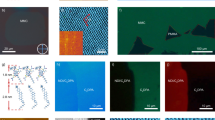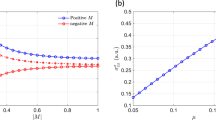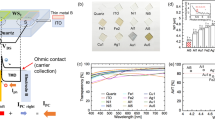Abstract
The p–n junction is the functional element of many electronic and optoelectronic devices, including diodes, bipolar transistors, photodetectors, light-emitting diodes and solar cells. In conventional p–n junctions, the adjacent p- and n-type regions of a semiconductor are formed by chemical doping. Ambipolar semiconductors, such as carbon nanotubes1, nanowires2 and organic molecules3, allow for p–n junctions to be configured and modified by electrostatic gating. This electrical control enables a single device to have multiple functionalities. Here, we report ambipolar monolayer WSe2 devices in which two local gates are used to define a p–n junction within the WSe2 sheet. With these electrically tunable p–n junctions, we demonstrate both p–n and n–p diodes with ideality factors better than 2. Under optical excitation, the diodes demonstrate a photodetection responsivity of 210 mA W–1 and photovoltaic power generation with a peak external quantum efficiency of 0.2%, promising values for a nearly transparent monolayer material in a lateral device geometry. Finally, we demonstrate a light-emitting diode based on monolayer WSe2. These devices provide a building block for ultrathin, flexible and nearly transparent optoelectronic and electronic applications based on ambipolar dichalcogenide materials.
This is a preview of subscription content, access via your institution
Access options
Subscribe to this journal
Receive 12 print issues and online access
$259.00 per year
only $21.58 per issue
Buy this article
- Purchase on Springer Link
- Instant access to full article PDF
Prices may be subject to local taxes which are calculated during checkout




Similar content being viewed by others
References
Martel, R. et al. Ambipolar electrical transport in semiconducting single-wall carbon nanotubes. Phys. Rev.Lett. 87, 256805 (2001).
Koo, S.-M., Li, Q., Edelstein, M., Richter, C. & Vogel, E. Enhanced channel modulation in dual-gated silicon nanowire transistors. Nano Lett. 5, 2519–2523 (2005).
Zaumseil, J. & Sirringhaus, H. Electron and ambipolar transport in organic field-effect transistors. Chem. Rev. 107, 1296–1323 (2007).
Bertolazzi, S., Brivio, J. & Kis, A. Stretching and breaking of ultrathin MoS2 . ACS Nano 5, 9703–9709 (2011).
Mak, K. F., Lee, C., Hone, J., Shan, J. & Heinz, T. F. Atomically thin MoS2: a new direct-gap semiconductor. Phys. Rev. Lett. 105, 136805 (2010).
Chuang, S. et al. Near-ideal electrical properties of InAs/WSe2 van der Waals heterojunction diodes. Appl. Phys. Lett. 102, 242101 (2013).
Tonndorf, P. et al. Photoluminescence emission and Raman response of monolayer MoS2, MoSe2, and WSe2 . Opt. Express 21, 4908–4916 (2013).
Zhao, W. et al. Evolution of electronic structure in atomically thin sheets of WS2 and WSe2 . ACS Nano 7, 791–797 (2013).
Geim, A. K. & Grigorieva, I. V. Van der Waals heterostructures. Nature 499, 419–425 (2013).
Wilson, J. & Yoffe, A. The transition metal dichalcogenides discussion and interpretation of the observed optical, electrical and structural properties. Adv. Phys. 18, 193–335 (1969).
Podzorov, V., Gershenson, M. E., Kloc, C., Zeis, R. & Bucher, E. High-mobility field-effect transistors based on transition metal dichalcogenides. Appl. Phys. Lett. 84, 3301–3303 (2004).
Radisavljevic, B. & Kis, A. Mobility engineering and a metal–insulator transition in monolayer MoS2 . Nature Mater. 12, 815–820 (2013).
Zhang, Y. J., Ye, J. T., Yomogida, Y., Takenobu, T. & Iwasa, Y. Formation of a stable p–n junction in a liquid-gated MoS2 ambipolar transistor. Nano Lett. 13, 3023–3028 (2013).
Wang, H. et al. Integrated circuits based on bilayer MoS2 transistors. Nano Lett. 12, 4674–4680 (2012).
Yin, Z. et al. Single-layer MoS2 phototransistors. ACS Nano 6, 74–80 (2012).
Lopez-Sanchez, O., Lembke, D., Kayci, M., Radenovic, A. & Kis, A. Ultrasensitive photodetectors based on monolayer MoS2 . Nature Nanotech. 8, 497–501 (2013).
Sundaram, R. S. et al. Electroluminescence in single layer MoS2 . Nano Lett. 13, 1416–1421 (2013).
Ye, Y. et al. Exciton-related electroluminescence from monolayer MoS2 . Preprint at http://lanl.arXiv.org/abs/1305.4235 (2013).
Zeng, H. et al. Optical signature of symmetry variations and spin-valley coupling in atomically thin tungsten dichalcogenides. Sci. Rep. 3, 1608 (2013).
Mak, K. F., He, K., Shan, J. & Heinz, T. F. Control of valley polarization in monolayer MoS2 by optical helicity. Nature Nanotech. 7, 494–498 (2012).
Sallen, G. et al. Robust optical emission polarization in MoS2 monolayers through selective valley excitation. Phys. Rev. B 86, 081301 (2012).
Jones, A. M. et al. Optical generation of excitonic valley coherence in monolayer WSe2 . Nature Nanotech. 8, 634–638 (2013).
Spah, R., Elrod, U., Luxsteiner, M., Bucher, E. & Wagner, S. PN junctions in tungsten diselenide. Appl. Phys. Lett. 43, 79–81 (1983).
Lee, J. U., Gipp, P. P. & Heller, C. M. Carbon nanotube p–n junction diodes. Appl. Phys. Lett. 85, 145–147 (2004).
Dean, C. R. et al. Boron nitride substrates for high-quality graphene electronics. Nature Nanotech. 5, 722–726 (2010).
Radisavljevic, B., Radenovic, A., Brivio, J., Giacometti, V. & Kis, A. Single-layer MoS2 transistors. Nature Nanotech. 6, 147–150 (2011).
Sah, C.-T., Noyce, R. N. & Shockley, W. Carrier generation and recombination in p–n junctions and p–n junction characteristics. Proc. IRE 45, 1228–1243 (1957).
Banwell, T. & Jayakumar, A. Exact analytical solution for current flow through diode with series resistance. Electron. Lett. 36, 291–292 (2000).
Buscema, M. et al. Large and tunable photo-thermoelectric effect in single-layer MoS2 . Nano Lett. 13, 358–363 (2013).
Huang, J.-K. et al. Large-area and highly crystalline WSe2 monolayers: from synthesis to device applications. ACS Nano 8, 923–930 (2014).
Li, X., Zhang, F. & Niu, Q. Unconventional quantum Hall effect and tunable spin Hall effect in Dirac materials: application to an isolated MoS2 trilayer. Phys. Rev. Lett. 110, 066803 (2013).
Pospischil, A., Furchi, M. M. & Mueller, T. Solar-energy conversion and light emission in an atomic monolayer p–n diode. Nature Nanotech. http://dx.doi.org/10.1038/nnano.2014.14 (2014).
Ross, J. et al. Electrically tunable excitonic light-emitting diodes based on monolayer WSe2 p–n junctions. Nature Nanotech. http://dx.doi.org/10.1038/nnano.2014.26 (2014).
Acknowledgements
The authors are grateful for experimental assistance provided by K. Akkaravarawong, T. Andersen, N. Gabor, Q. Lin, Q. Ma, W. Fang and J. Sanchez-Yamagishi, as well as for discussions with P. Brown. This work was primarily funded by the Office of Naval Research Young Investigator Award (N00014-13-1-0610) and partly by the Office of Naval Research Graphene Approaches to Terahertz Electronics Multidisciplinary University Research Initiative and a Packard Fellowship. This work made use of the Materials Research Science and Engineering Center Shared Experimental Facilities supported by the National Science Foundation (NSF) (award no. DMR-0819762) and of Harvard's Center for Nanoscale Systems, supported by the NSF (grant ECS-0335765).
Author information
Authors and Affiliations
Contributions
B.W.H.B., H.O.H.C. and Y.Y. fabricated the samples. B.W.H.B., H.O.H.C. and Y.Y. performed the measurements. All authors analysed the data and co-wrote the paper.
Corresponding author
Ethics declarations
Competing interests
The authors declare no competing financial interests.
Supplementary information
Supplementary information
Supplementary information (PDF 531 kb)
Rights and permissions
About this article
Cite this article
Baugher, B., Churchill, H., Yang, Y. et al. Optoelectronic devices based on electrically tunable p–n diodes in a monolayer dichalcogenide. Nature Nanotech 9, 262–267 (2014). https://doi.org/10.1038/nnano.2014.25
Received:
Accepted:
Published:
Issue Date:
DOI: https://doi.org/10.1038/nnano.2014.25
This article is cited by
-
Graphene/Al2O3/Si Schottky diode with integrated waveguide on a silicon-on-insulator wafer
Indian Journal of Physics (2024)
-
Effect of compressive strain on electronic and optical properties of Cr-doped monolayer WS2
Journal of Molecular Modeling (2024)
-
Reconfigurable logic and in-sensor encryption operations in an asymmetrically tunable van der Waals heterostructure
Nano Research (2024)
-
Lead halide perovskite sensitized WSe2 photodiodes with ultrahigh open circuit voltages
eLight (2023)
-
Dynamical characteristics of AC-driven hybrid WSe2 monolayer/AlGaInP quantum wells light-emitting device
Discover Nano (2023)



